These archive pages are provided in order to make it easier for you to find items
that you remember seeing on the Airplanes and Rockets homepage. Of course probably
the easiest way to find anything on the website is to use the "Search AAR" box at
the top of every page.
1 |
2 |
3 |
4 |
5 |
6 |
7 |
8 |
9 |
10 |
11 |
12 |
13 |
14 |
15 |
16 |
17 |
18 |
19 |
20
21 |
22 |
23 |
24 |
25 |
26 |
27 |
28 |
29 |
30 |
31 |
32 |
33 |
34 |
35 |
36 | 37
| 38 | 39
 Airplanes and Rockets website visitor Lars
B. wrote from Sweden requesting that I scan this "Wind Flying" article from
the September 1972 edition of American Aircraft Modeler magazine. It describes
a method for replacing engines and motors with human power for preforming some pretty
impressive C/L aerobatics on windy days. Basically, you drag the model airplane
around on its control lines, which often required not just turning in a circle while
standing in one place, but walking around a small circle in order to get more speed.
If there is any wind, you need to put extra effort into the pulling when moving
into the wind. I can remember doing this as a teenager, only I did it with the engine
in place but not... Airplanes and Rockets website visitor Lars
B. wrote from Sweden requesting that I scan this "Wind Flying" article from
the September 1972 edition of American Aircraft Modeler magazine. It describes
a method for replacing engines and motors with human power for preforming some pretty
impressive C/L aerobatics on windy days. Basically, you drag the model airplane
around on its control lines, which often required not just turning in a circle while
standing in one place, but walking around a small circle in order to get more speed.
If there is any wind, you need to put extra effort into the pulling when moving
into the wind. I can remember doing this as a teenager, only I did it with the engine
in place but not...
• FCC Rules for
5 GHz Band Drone Operations
•
EAA Weighs in on MOSAIC
• Smithsonian
Opens Hangar Doors to Pilots
• EAA AirVenture Oshkosh 2024 July 22-28
• The Smallest
Air Force One
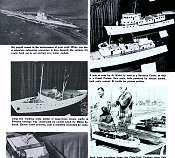 Post World War II was a big time for
model building and operating. Veterans and their families helped relieve the stress
and anxieties of the era with both scale and original design
model boats, cars, trains,
submarines, motorcycles helicopters, airplanes, tanks, even oddities like bicycles,
farm equipment, carnival layouts, animals, and historic buildings (of which
many of those appeared in model train layouts). The level of artistry and craftsmanship
was impressive, particularly considering the sparsity of pre-made miniature accoutrements
like hardware fittings, mechanisms for operating control surfaces and mechanisms,
and even appropriate finishes. Radio control was in its infancy, being largely the
realm of modelers with knowledge... Post World War II was a big time for
model building and operating. Veterans and their families helped relieve the stress
and anxieties of the era with both scale and original design
model boats, cars, trains,
submarines, motorcycles helicopters, airplanes, tanks, even oddities like bicycles,
farm equipment, carnival layouts, animals, and historic buildings (of which
many of those appeared in model train layouts). The level of artistry and craftsmanship
was impressive, particularly considering the sparsity of pre-made miniature accoutrements
like hardware fittings, mechanisms for operating control surfaces and mechanisms,
and even appropriate finishes. Radio control was in its infancy, being largely the
realm of modelers with knowledge...
 Website visitor Steve R. wrote requesting
that I scan and post this "Square Hare" article from the September 1962 issue of
American Modeler magazine. Says, Steve, "I built one of these back then
on Galloping ghost and it went great till servo failed (modified mighty Midget motor).
Later I built another for Class one Aerobatics fitted with OS 40 and Kraft Propo,
this was very successful. Nostalgia strikes and I'd like to build another as a sport
model." Square Hare from Delaware is a bit unique in that its wing has no spar and
is constructed from diagonally arranged ribs sandwiched between 3/32" balsa sheeting.
Looking at all the hardware required just for the elevator control really makes
you appreciate modern radio gear with servos. Hopefully, Steve will grace us with
a photo of his completed Square Hare. Website visitor Steve R. wrote requesting
that I scan and post this "Square Hare" article from the September 1962 issue of
American Modeler magazine. Says, Steve, "I built one of these back then
on Galloping ghost and it went great till servo failed (modified mighty Midget motor).
Later I built another for Class one Aerobatics fitted with OS 40 and Kraft Propo,
this was very successful. Nostalgia strikes and I'd like to build another as a sport
model." Square Hare from Delaware is a bit unique in that its wing has no spar and
is constructed from diagonally arranged ribs sandwiched between 3/32" balsa sheeting.
Looking at all the hardware required just for the elevator control really makes
you appreciate modern radio gear with servos. Hopefully, Steve will grace us with
a photo of his completed Square Hare.
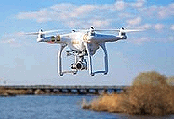 "On September 9, the House of Representatives
passed H.R.2864: the
Countering CCP Drones Act. This would add future equipment made by DJI technologies
to the FCC's Covered List on the premise that it poses a risk to U.S. national security.
The Countering CCP Drones Act would essentially ban UAS and related tech produced
by DJI from operating on U.S. telecommunications infrastructure. This trails several
'inaccurate and unsubstantiated' claims against the company regarding sensitive
data sharing with the Chinese Communist Party (CCP). This would not directly affect
customers, at least for now, though it is guaranteed to have a massive effect on
DJI's..." "On September 9, the House of Representatives
passed H.R.2864: the
Countering CCP Drones Act. This would add future equipment made by DJI technologies
to the FCC's Covered List on the premise that it poses a risk to U.S. national security.
The Countering CCP Drones Act would essentially ban UAS and related tech produced
by DJI from operating on U.S. telecommunications infrastructure. This trails several
'inaccurate and unsubstantiated' claims against the company regarding sensitive
data sharing with the Chinese Communist Party (CCP). This would not directly affect
customers, at least for now, though it is guaranteed to have a massive effect on
DJI's..."
 I had no idea that there were multiple versions
of the Ford
Trimotor (aka Tin Goose). This article from an 1962 edition of American
Modeler magazine provides a fairly in-depth look at the history of the airplane.
If you follow politics at all, you know that Halliburton is a name that became a
household word when George Bush chose Dick Cheney as his vice president. According
to author Joe Christy, SAFE-way airline, which operated Ford Trimotors, was started
by Oklahoma oilman Erle Halliburton, and was sold to TWA (Trans World Airline) in
1931. In an incredible stroke of good fortune, Melanie and I were able to take a
ride in a Ford Trimotor in the summer of 2013, flying out of Erie International
Airport (see my Ford Trimotor video)... I had no idea that there were multiple versions
of the Ford
Trimotor (aka Tin Goose). This article from an 1962 edition of American
Modeler magazine provides a fairly in-depth look at the history of the airplane.
If you follow politics at all, you know that Halliburton is a name that became a
household word when George Bush chose Dick Cheney as his vice president. According
to author Joe Christy, SAFE-way airline, which operated Ford Trimotors, was started
by Oklahoma oilman Erle Halliburton, and was sold to TWA (Trans World Airline) in
1931. In an incredible stroke of good fortune, Melanie and I were able to take a
ride in a Ford Trimotor in the summer of 2013, flying out of Erie International
Airport (see my Ford Trimotor video)...
 The
1955 Academy of Model Aeronautics (AMA) National Model Airplane Championships,
held at the Los Alamitos, California, Naval Air Station was by all measures a smashing
success - "the best run Nationals competition in history." Extensive coverage of
the event appeared in the Annual Edition of Air Trails magazine. Free flight
and control line model airplanes were there, but no radio control types attended;
the technology was not yet within reach of enough hobbyists to warrant inclusion.
A look at the photos makes evident the amazing quality and variation of models,
both scale and non-scale. Take a look at the F4U Corsair with the folding wings,
the Ford Trimotor, Fairchild C-119, and the Fokker DR-1 triplane. Speaking of quality
models, two of the feminine kind were on-hand to award trophies. Hillevi Rombin,
Miss Universe of 1955, and movie starlet Marla English, are pictured with two lucky
winners.. The
1955 Academy of Model Aeronautics (AMA) National Model Airplane Championships,
held at the Los Alamitos, California, Naval Air Station was by all measures a smashing
success - "the best run Nationals competition in history." Extensive coverage of
the event appeared in the Annual Edition of Air Trails magazine. Free flight
and control line model airplanes were there, but no radio control types attended;
the technology was not yet within reach of enough hobbyists to warrant inclusion.
A look at the photos makes evident the amazing quality and variation of models,
both scale and non-scale. Take a look at the F4U Corsair with the folding wings,
the Ford Trimotor, Fairchild C-119, and the Fokker DR-1 triplane. Speaking of quality
models, two of the feminine kind were on-hand to award trophies. Hillevi Rombin,
Miss Universe of 1955, and movie starlet Marla English, are pictured with two lucky
winners..
 Ummm... was this really a "space walk?"
If so, then I "sky walked" when I climbed to the top of my 6-foot wooden ladder
yesterday. "The world's first commercial space walk, performed by billionaire
Jared Isaacman and SpaceX engineer Sarah Gillis, tested new technology and was practically
flawless. It wasn't a small step - more a clamber, really - but as billionaire entrepreneur
Jared Isaacman
climbed partway out of a SpaceX Dragon capsule located nearly 740 kilometers
above Earth on early Thursday morning, he made a giant leap into spaceflight history.
That's because Isaacman is a private citizen who is flying in a commercial spacecraft
on a voyage he paid for - not a government-agency... Ummm... was this really a "space walk?"
If so, then I "sky walked" when I climbed to the top of my 6-foot wooden ladder
yesterday. "The world's first commercial space walk, performed by billionaire
Jared Isaacman and SpaceX engineer Sarah Gillis, tested new technology and was practically
flawless. It wasn't a small step - more a clamber, really - but as billionaire entrepreneur
Jared Isaacman
climbed partway out of a SpaceX Dragon capsule located nearly 740 kilometers
above Earth on early Thursday morning, he made a giant leap into spaceflight history.
That's because Isaacman is a private citizen who is flying in a commercial spacecraft
on a voyage he paid for - not a government-agency...
 Here are plans for the
Boeing B&W 1916
Biplane that I electronically scanned from my purchased copy of the March 1965
Model Airplane News magazine. When I have more time, I will dig the magazine
out of storage and scan/OCR the rest of the article. For now you can at least review
the plans. Click on the images for larger versions. I have even large files for
them at the original 200 dpi resolution. Designed and built by Mr. Francis Reynolds.
Plans for this fine model were drawn by Mr. Ray Vinup. All copyrights (if any) are
hereby acknowledged. "The Boeing Model 1, also known as the B & W Seaplane,
was a United States single-engine biplane seaplane aircraft. It was the first Boeing
product and carried the initials..." Here are plans for the
Boeing B&W 1916
Biplane that I electronically scanned from my purchased copy of the March 1965
Model Airplane News magazine. When I have more time, I will dig the magazine
out of storage and scan/OCR the rest of the article. For now you can at least review
the plans. Click on the images for larger versions. I have even large files for
them at the original 200 dpi resolution. Designed and built by Mr. Francis Reynolds.
Plans for this fine model were drawn by Mr. Ray Vinup. All copyrights (if any) are
hereby acknowledged. "The Boeing Model 1, also known as the B & W Seaplane,
was a United States single-engine biplane seaplane aircraft. It was the first Boeing
product and carried the initials..."
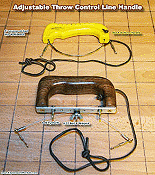 When building my Enterprise-E control stunt
airplane, I knew that the amount of control surface throw available for both flaps
and elevator was extreme, but I wanted to have the reserve capability in case it
was needed. It was definitely NOT needed! Fortunately, because of the way the top
fuselage hatch is designed for removal there is easy access to the flap control
horn, and thereby the ability to move pushrod clevises around to decrease throws.
Even with doing that, however, the model is still very sensitive to control line
handle movements. My only solution was to obtain a
control line handle
with line spacing less than the 4-1/4" on the stock Sullivan handle. That spacing
has been a little too much for other models as well, so an alternate handle would
be nice anyway... When building my Enterprise-E control stunt
airplane, I knew that the amount of control surface throw available for both flaps
and elevator was extreme, but I wanted to have the reserve capability in case it
was needed. It was definitely NOT needed! Fortunately, because of the way the top
fuselage hatch is designed for removal there is easy access to the flap control
horn, and thereby the ability to move pushrod clevises around to decrease throws.
Even with doing that, however, the model is still very sensitive to control line
handle movements. My only solution was to obtain a
control line handle
with line spacing less than the 4-1/4" on the stock Sullivan handle. That spacing
has been a little too much for other models as well, so an alternate handle would
be nice anyway...
 I received a lot of feedback after first
posting this piece on how to straighten cupped
and/or bowed laminated countertops. That was a couple years ago. Since I continue
to see severely deformed countertops in Lowes and Home Depot, it is worth brining
attention to it again. You might be able to get a really good deal on the otherwise
unsellable laminated countertops, then use my easy method for nearly perfectly flattening
them. Al that is required is sawing a cross-hatch pattern part-way through the bottom
surface, and then screwing, gluing, and clamping them whilst being held flat. The
wood around the outside edge serves as the space normally placed between the top
of the lower cabinet base and the countertop. Tyr it. You'll like it! I received a lot of feedback after first
posting this piece on how to straighten cupped
and/or bowed laminated countertops. That was a couple years ago. Since I continue
to see severely deformed countertops in Lowes and Home Depot, it is worth brining
attention to it again. You might be able to get a really good deal on the otherwise
unsellable laminated countertops, then use my easy method for nearly perfectly flattening
them. Al that is required is sawing a cross-hatch pattern part-way through the bottom
surface, and then screwing, gluing, and clamping them whilst being held flat. The
wood around the outside edge serves as the space normally placed between the top
of the lower cabinet base and the countertop. Tyr it. You'll like it!
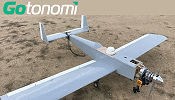 "Gotonomi,
a UAV satellite connectivity solutions provider, has announced the completion of
further successful flight trials and the opening of orders for production units
of all variants of its
UAV satcom terminals at Commercial UAV Expo 2024 in Las Vegas. The launch marks
a significant milestone, transitioning from pre-production flight development kits
to type-approved, commercial terminals, enabling scalable beyond visual line of
sight operations (BVLOS) for drone operators wishing to offer inspection, surveillance,
and delivery services. Following extensive verification testing, including flight
trials..." "Gotonomi,
a UAV satellite connectivity solutions provider, has announced the completion of
further successful flight trials and the opening of orders for production units
of all variants of its
UAV satcom terminals at Commercial UAV Expo 2024 in Las Vegas. The launch marks
a significant milestone, transitioning from pre-production flight development kits
to type-approved, commercial terminals, enabling scalable beyond visual line of
sight operations (BVLOS) for drone operators wishing to offer inspection, surveillance,
and delivery services. Following extensive verification testing, including flight
trials..."
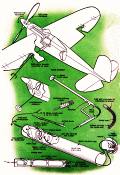 When I first saw this "U-Control
Model Plane" article in a 1952 issue of Popular Mechanics magazine,
I expected it to have been written by one of the Stanzel brothers. Long after their
entry into the model airplane manufacturing world, Joe and Victor created their
line of battery-powered, electric motor-driven control line models in 1958. It eventually
included a helicopter, a monoplane, and a flying saucer, amongst other craft. The
Stanzels, BTW, invented the Monoline control line system which was adopted by U-control
(aka control line) speed modelers because it created much less aerodynamic drag,
facilitating higher airspeeds. Maybe this article was a motivation for the Stanzels... When I first saw this "U-Control
Model Plane" article in a 1952 issue of Popular Mechanics magazine,
I expected it to have been written by one of the Stanzel brothers. Long after their
entry into the model airplane manufacturing world, Joe and Victor created their
line of battery-powered, electric motor-driven control line models in 1958. It eventually
included a helicopter, a monoplane, and a flying saucer, amongst other craft. The
Stanzels, BTW, invented the Monoline control line system which was adopted by U-control
(aka control line) speed modelers because it created much less aerodynamic drag,
facilitating higher airspeeds. Maybe this article was a motivation for the Stanzels...
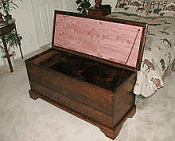 Another of Melanie's family's relics is
this pine clothes
chest. After more than 100 years of use and abuse, this chest was in dire need
of restoration. Construction is very low density pine, with dovetailed corners.
Finish was a clear varnish with no stain. The bottom, back, and inside had no finish
at all. Restoration consisted of knocking apart and re-gluing most joints, sanding,
and filling in the multiple dings and scratches where they were really deep. Minor
imperfections were kept for the sake of character. Minwax dark walnut stain was
used inside and out, and allowed to dry for a week. Then, two coats of Deft satin
clear were brushed on with 320 sanding and 0000 steel wool between coats... Another of Melanie's family's relics is
this pine clothes
chest. After more than 100 years of use and abuse, this chest was in dire need
of restoration. Construction is very low density pine, with dovetailed corners.
Finish was a clear varnish with no stain. The bottom, back, and inside had no finish
at all. Restoration consisted of knocking apart and re-gluing most joints, sanding,
and filling in the multiple dings and scratches where they were really deep. Minor
imperfections were kept for the sake of character. Minwax dark walnut stain was
used inside and out, and allowed to dry for a week. Then, two coats of Deft satin
clear were brushed on with 320 sanding and 0000 steel wool between coats...
 "The SETI Institute, in collaboration with
the Berkeley SETI Research Center and the International Centre for Radio Astronomy
Research, has initiated a pioneering study using the Murchison Widefield Array (MWA)
in Western Australia. Led by Dr. Chenoa Tremblay of the SETI Institute and Prof.
Steven Tingay of Curtin University, this research marks the first
search for alien technology in galaxies beyond our own, specifically targeting
low radio frequencies (100 MHz). The MWA's extensive field of view (FOV) allowed
the research team to examine approximately 2,800 galaxies in a single observation,
with known distances for 1,300 of these galaxies..." "The SETI Institute, in collaboration with
the Berkeley SETI Research Center and the International Centre for Radio Astronomy
Research, has initiated a pioneering study using the Murchison Widefield Array (MWA)
in Western Australia. Led by Dr. Chenoa Tremblay of the SETI Institute and Prof.
Steven Tingay of Curtin University, this research marks the first
search for alien technology in galaxies beyond our own, specifically targeting
low radio frequencies (100 MHz). The MWA's extensive field of view (FOV) allowed
the research team to examine approximately 2,800 galaxies in a single observation,
with known distances for 1,300 of these galaxies..."
 This report of the
1962 (16th) British Nationals
appeared in the 1963 Annular edition of American Modeler modeler, which
I believe was published in January of 1963. Just as back in the day, the U.S. Nationals
were held on a military installation (U.S. Navy sponsorship), the British Nats were
held at Barkston Heath R.A.F. station. Although technically it was an international
event, it appears that Brits and Yanks were the only competitors - or at least the
only ones mentioned. See anyone you know? This report of the
1962 (16th) British Nationals
appeared in the 1963 Annular edition of American Modeler modeler, which
I believe was published in January of 1963. Just as back in the day, the U.S. Nationals
were held on a military installation (U.S. Navy sponsorship), the British Nats were
held at Barkston Heath R.A.F. station. Although technically it was an international
event, it appears that Brits and Yanks were the only competitors - or at least the
only ones mentioned. See anyone you know?
 When
Dyna-Jet engine in new or like-new condition is listed for sale or auction on
eBay, it usually sells for north of $500. Sometimes buyers get lucky and win an
auction for less. This 1946 Popular Science magazine article entitled "Baby V-1
Flies for Fun" appeared just a year after Germany had surrendered unconditionally.
Only a year before that, Londoners ran for cover in underground shelters when V-1
"Buzz Bombs" were heard making their tell-tale 45 Hz "buzz" noise as they made
their way toward England. "V-1" was from the German Vergeltungswaffe 1 meaning
"Vengeance Weapon 1." The only reference to a "robomb" I see other than this
article is from a 1944 issue of Time magazines entitled, "Science: How the Robomb
Works." As Paul Harvey would famously say, "Now you know... the Rest of the story." When
Dyna-Jet engine in new or like-new condition is listed for sale or auction on
eBay, it usually sells for north of $500. Sometimes buyers get lucky and win an
auction for less. This 1946 Popular Science magazine article entitled "Baby V-1
Flies for Fun" appeared just a year after Germany had surrendered unconditionally.
Only a year before that, Londoners ran for cover in underground shelters when V-1
"Buzz Bombs" were heard making their tell-tale 45 Hz "buzz" noise as they made
their way toward England. "V-1" was from the German Vergeltungswaffe 1 meaning
"Vengeance Weapon 1." The only reference to a "robomb" I see other than this
article is from a 1944 issue of Time magazines entitled, "Science: How the Robomb
Works." As Paul Harvey would famously say, "Now you know... the Rest of the story."
 SpaceX
and Blue Origin have been in the news for the last decade for their efforts (some
successful, some not) to
autonomously land a spacecraft vertically under its own power. Love it or hate
it, NASA has been doing that for nearly six decades. Granted, it was on celestial
bodies with lower gravitational acceleration than on Earth, but the earliest craft
(Surveyor 1, 1966) had relatively crude electronics aboard, including a Doppler
radar, flight computer, and video camera. The now legendary Apollo Guidance Computer
has been written about extensively, and is a testimony to the brilliance of the
scientists, engineers, managers, operators, and technicians who built and flew it.
Articles like this one in the May 1967 issue of Radio-Electronics magazine... SpaceX
and Blue Origin have been in the news for the last decade for their efforts (some
successful, some not) to
autonomously land a spacecraft vertically under its own power. Love it or hate
it, NASA has been doing that for nearly six decades. Granted, it was on celestial
bodies with lower gravitational acceleration than on Earth, but the earliest craft
(Surveyor 1, 1966) had relatively crude electronics aboard, including a Doppler
radar, flight computer, and video camera. The now legendary Apollo Guidance Computer
has been written about extensively, and is a testimony to the brilliance of the
scientists, engineers, managers, operators, and technicians who built and flew it.
Articles like this one in the May 1967 issue of Radio-Electronics magazine...
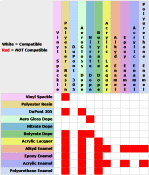 I am not aware of the origin of this matrix,
but it is a very useful tool for determining whether certain
filler materials
and finish chemistries are compatible or, equally important, incompatible. It
was included in the July 2012 edition of the Bean Hill Flyers control-line club
newsletter. This might save somebody the grief and angst from applying a finish
over a base that will cause it to bubble, peel, blister, or not ever dry. One important
point this chart indicates is that you can apply butyrate dope over nitrate dope,
but you CANNOT apply nitrate dope over butyrate dope. There might be other instances
of one-way compatibilities, but if you are not sure, do a test first or avoid the
deadly combination altogether. You also need to verify compatibility of the various
rattle can... I am not aware of the origin of this matrix,
but it is a very useful tool for determining whether certain
filler materials
and finish chemistries are compatible or, equally important, incompatible. It
was included in the July 2012 edition of the Bean Hill Flyers control-line club
newsletter. This might save somebody the grief and angst from applying a finish
over a base that will cause it to bubble, peel, blister, or not ever dry. One important
point this chart indicates is that you can apply butyrate dope over nitrate dope,
but you CANNOT apply nitrate dope over butyrate dope. There might be other instances
of one-way compatibilities, but if you are not sure, do a test first or avoid the
deadly combination altogether. You also need to verify compatibility of the various
rattle can...
 According to Guiness World Records, the
current holder of the record for the
fastest model car is the "Radio Controlled Bullet," by Nic Case, having achieved
a speed of 202.02 mph (325.12 km/h), in 2014. In 2019, Estonian Ando Rohtmets set
the tethered model car speed record of 215.92 mph (347.490 kmph). All
modern speed records are set using electric motor power, unlike these models reported
on in a 1948 issue of Popular Science magazine which used liquid fuel and
internal combustion engines (ICE). However, not all of those ICE powerplants had
pistons. Mr. Frank Brennan showed up with a DynaJet-powered model car, purportedly
fashioned after the Nazi V-1 "Buzz Bomb" (remember this was only a couple years
past... According to Guiness World Records, the
current holder of the record for the
fastest model car is the "Radio Controlled Bullet," by Nic Case, having achieved
a speed of 202.02 mph (325.12 km/h), in 2014. In 2019, Estonian Ando Rohtmets set
the tethered model car speed record of 215.92 mph (347.490 kmph). All
modern speed records are set using electric motor power, unlike these models reported
on in a 1948 issue of Popular Science magazine which used liquid fuel and
internal combustion engines (ICE). However, not all of those ICE powerplants had
pistons. Mr. Frank Brennan showed up with a DynaJet-powered model car, purportedly
fashioned after the Nazi V-1 "Buzz Bomb" (remember this was only a couple years
past...
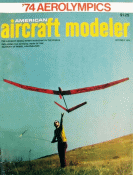 The
Eclipse is a gigantic
radio-controlled sailplane model with a 16-foot wingspan, geodesic ribs construction,
and "V" tail configuration. It is built up from balsa, plywood, spruce, and a fiberglass
tail boom. I remember first seeing the model on the cover of the October 1974 issue
of American Aircraft Modeler magazine, and really wanting to build one.
Unfortunately, I was only 16 years old at the time and was barely able to afford
control line models, let alone a huge RC sailplane. Of course with the cost of balsa
today, it is no more affordable now as then. It probably takes four rolls of Monokote
to cover! Here are plans for the Eclipse that I electronically scanned from my purchased
copy AAM. You might be able to scale up the image... The
Eclipse is a gigantic
radio-controlled sailplane model with a 16-foot wingspan, geodesic ribs construction,
and "V" tail configuration. It is built up from balsa, plywood, spruce, and a fiberglass
tail boom. I remember first seeing the model on the cover of the October 1974 issue
of American Aircraft Modeler magazine, and really wanting to build one.
Unfortunately, I was only 16 years old at the time and was barely able to afford
control line models, let alone a huge RC sailplane. Of course with the cost of balsa
today, it is no more affordable now as then. It probably takes four rolls of Monokote
to cover! Here are plans for the Eclipse that I electronically scanned from my purchased
copy AAM. You might be able to scale up the image...
 The Estes
Saturn 1B rocket is another model that
I really wanted to have as a kid, but just didn't have the money. In those days,
I launched everything that I built, so I could not see spending a huge amount of
my paper route money only to take the risk of destruction due to the parachutes
not deploying properly or maybe an engine malfunction. I had launched enough rockets
to know that the probability of something going wrong was directly proportional
to the cost and time spent building. Instead, I stuck mostly with models that cost
no more than about $3 (in 1960s-1970s dollars). This Saturn 1B model has long
been in my rocket building queue, but decade passed before I felt justified spending
the money and time to buy and build one. The Saturn 1B was one of the Saturn V's
predecessors and was used as the launch vehicle for the first few Apollo missions... The Estes
Saturn 1B rocket is another model that
I really wanted to have as a kid, but just didn't have the money. In those days,
I launched everything that I built, so I could not see spending a huge amount of
my paper route money only to take the risk of destruction due to the parachutes
not deploying properly or maybe an engine malfunction. I had launched enough rockets
to know that the probability of something going wrong was directly proportional
to the cost and time spent building. Instead, I stuck mostly with models that cost
no more than about $3 (in 1960s-1970s dollars). This Saturn 1B model has long
been in my rocket building queue, but decade passed before I felt justified spending
the money and time to buy and build one. The Saturn 1B was one of the Saturn V's
predecessors and was used as the launch vehicle for the first few Apollo missions...
 Jetex "rocket" motors were quite popular
during the 1940s through the 1970s. Their debut in the modeling world was in 1948,
per the Jetex.org website. Unlike Estes rocket engines that used combustion to generate
a high velocity ejection stream, Jetex fuel pellets merely "burned" at a constant
rate while the exhaust was forced through a small orifice in the engine's metal
housing (casing). Also unlike Estes engines, the Jetex casing was reusable and re-fuelable.
Half a dozen or so sizes and thrust levels eventually were produced. I had a couple
of the Jetex 50 engines that got strapped to Guillows balsa gliders and, to
some degree, were made to fly in jet-like fashion... Jetex "rocket" motors were quite popular
during the 1940s through the 1970s. Their debut in the modeling world was in 1948,
per the Jetex.org website. Unlike Estes rocket engines that used combustion to generate
a high velocity ejection stream, Jetex fuel pellets merely "burned" at a constant
rate while the exhaust was forced through a small orifice in the engine's metal
housing (casing). Also unlike Estes engines, the Jetex casing was reusable and re-fuelable.
Half a dozen or so sizes and thrust levels eventually were produced. I had a couple
of the Jetex 50 engines that got strapped to Guillows balsa gliders and, to
some degree, were made to fly in jet-like fashion...
 Infographics are a big thing (literally)
in the business and science world, although they do seem to have passed their prime.
Well-done infographics typically have the form of a high aspect ratio drawing that
presents a detailed timeline or process flow of events or concepts. The progress
can run top to bottom or bottom to top, depending on the creator's intentions. This
particular infographic, produced by the BBC's "Great Turning Points"
series, outlines the major milestones in development of flying machines beginning
with the Wright Flyer in 1903 and progressing through both manned and unmanned airplanes
up through the U.S... Infographics are a big thing (literally)
in the business and science world, although they do seem to have passed their prime.
Well-done infographics typically have the form of a high aspect ratio drawing that
presents a detailed timeline or process flow of events or concepts. The progress
can run top to bottom or bottom to top, depending on the creator's intentions. This
particular infographic, produced by the BBC's "Great Turning Points"
series, outlines the major milestones in development of flying machines beginning
with the Wright Flyer in 1903 and progressing through both manned and unmanned airplanes
up through the U.S...
 Notice
to TSgt. Ford's daughter: Please contact me again; the Academy of Model Aeronautics
(AMA) is interested in getting more information about your father. Notice
to TSgt. Ford's daughter: Please contact me again; the Academy of Model Aeronautics
(AMA) is interested in getting more information about your father.
In 1970, when this article was written about
USAF TSgt. Gordon Ford's incredible collection of giant control line scale, multi-engined
flying models, the KC-135 Stratotanker was still a decade from being replaced
by the KC-10, the C-5A Galaxy was just coming online as the world's largest cargo
aircraft, and the C-133 Cargomaster was about to be mothballed. C-124 Globemasters
were on their last legs, the XB-70 Valkyrie was a bygone dream, and the Convair
T-29 (C-131) only had a few good years left in her. These are just a few of the
aircraft in SSgt. Ford's hangar. How he was able to transport...
 "The FAA released a substantial update to
their
Guide for Aviation Medical Examiners that includes major improvements for the
agency's protocols for mental health, coronary heart disease, and some ophthalmologic
conditions. The "AME Guide" serves as the main public-facing document for medical
policy published by the FAA. In the following story, we will summarize the highlights
of these policy changes by diagnosis category. Mental Health Among the most anticipated
changes are those to mental health policy. For the first time, individuals with
a history of certain "uncomplicated" diagnoses that have been treated..." "The FAA released a substantial update to
their
Guide for Aviation Medical Examiners that includes major improvements for the
agency's protocols for mental health, coronary heart disease, and some ophthalmologic
conditions. The "AME Guide" serves as the main public-facing document for medical
policy published by the FAA. In the following story, we will summarize the highlights
of these policy changes by diagnosis category. Mental Health Among the most anticipated
changes are those to mental health policy. For the first time, individuals with
a history of certain "uncomplicated" diagnoses that have been treated..."
 For some reason, in more than half a century
building and flying model airplanes, I have never owned or operated a
diesel engine. I have nothing against them, and in fact would like to procure
and run one, even if just on a test stand, before assuming dirt temperature. Diesels
have a couple advantages and disadvantages compared to glow fuel engines, according
to my recollection from reading about them over the years. Compared to glow fuel
engines, diesels produce less power for a given volume displacement. The absence
of a glow plug can make them more difficult to start, especially when hand-flipping
and/or in cold weather. To their credit, diesels are not quite as... For some reason, in more than half a century
building and flying model airplanes, I have never owned or operated a
diesel engine. I have nothing against them, and in fact would like to procure
and run one, even if just on a test stand, before assuming dirt temperature. Diesels
have a couple advantages and disadvantages compared to glow fuel engines, according
to my recollection from reading about them over the years. Compared to glow fuel
engines, diesels produce less power for a given volume displacement. The absence
of a glow plug can make them more difficult to start, especially when hand-flipping
and/or in cold weather. To their credit, diesels are not quite as...
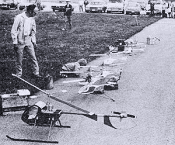 If only 15 pilots were to enter helicopters
in the 2024 Nats, everyone would wonder what in the world has gone drastically wrong.
Heck, in today's contest it probably isn't unusual for a single contestant to show
up with as many as 15 of his own helicopters - one for each type of event (aerobatics,
scale, etc.) and a couple back-ups for each. A mix of homemade, commercial kits,
and modified kits were displayed. Schluter was selling it Hueycobra, and DuBro had
its Whirlybird. Their prototype Hughes 300 showed up, too. In 1972 when this
issue of American Aircraft Modeler magazine was published, 15 pilots with
a total of 17 - including free flight types -
helicopters
participating in the Nats was heralded as ground-breaking. How times have changed... If only 15 pilots were to enter helicopters
in the 2024 Nats, everyone would wonder what in the world has gone drastically wrong.
Heck, in today's contest it probably isn't unusual for a single contestant to show
up with as many as 15 of his own helicopters - one for each type of event (aerobatics,
scale, etc.) and a couple back-ups for each. A mix of homemade, commercial kits,
and modified kits were displayed. Schluter was selling it Hueycobra, and DuBro had
its Whirlybird. Their prototype Hughes 300 showed up, too. In 1972 when this
issue of American Aircraft Modeler magazine was published, 15 pilots with
a total of 17 - including free flight types -
helicopters
participating in the Nats was heralded as ground-breaking. How times have changed...
 Steve Wittman, aka "The Grand Old Man of
Air Racing," was a prolific airplane designer, builder, and pilot. His Wittman Tailwind
homebuilt airplane was very popular and proved to be fast and efficient for its
size and power. The "Formula Vee" racer, motivated by a highly modified Volkswagen
engine, easily broke the 170 mph speed benchmark. Making outside-of-the-box tradeoffs
like suffering the drag of wing bracing wires for a lighter and thinner airfoil
are what made Wittman a crafty - and winning - designer. A scale model of the
Wittman Vee might benefit
from a slightly thicker airfoil and larger tail surfaces unless you want to have
to aggressively fly the craft the entire time it is in the air. This article
and 3-view of Witt's Vee appeared in a 1974 issue of American Aircraft Modeler
magazine... Steve Wittman, aka "The Grand Old Man of
Air Racing," was a prolific airplane designer, builder, and pilot. His Wittman Tailwind
homebuilt airplane was very popular and proved to be fast and efficient for its
size and power. The "Formula Vee" racer, motivated by a highly modified Volkswagen
engine, easily broke the 170 mph speed benchmark. Making outside-of-the-box tradeoffs
like suffering the drag of wing bracing wires for a lighter and thinner airfoil
are what made Wittman a crafty - and winning - designer. A scale model of the
Wittman Vee might benefit
from a slightly thicker airfoil and larger tail surfaces unless you want to have
to aggressively fly the craft the entire time it is in the air. This article
and 3-view of Witt's Vee appeared in a 1974 issue of American Aircraft Modeler
magazine...
 Website visitor Kenneth E. wrote to say
that he is working to build a complete collection of the Tenderfoot models that
were published in American Aircraft Modeler magazine. The Tenderfoot series
was an attempt to provide motivation to young newcomers to the hobby. They were
a mix of freeflight rubber, gliders, control line designs that built simply and
cheaply. Power could be muscle (hand launch), CO2, rubber band (wind-up or catapult
launch), and and internal combustion engine 1/4A (.010 and .020) & 1/2A (.049
and .051) using glow fuel or diesel fuel. Kenneth requested reprints of the following
three models: The Saucerer,
a unique control line model by Ray Malmström (January 1970), the Bonanza and Mustang,
free flight hand-launched glider by David Thornburg (January 1971), and the Clodhopper
free flight rubber powered model by Paul Denson (February 1973)... Website visitor Kenneth E. wrote to say
that he is working to build a complete collection of the Tenderfoot models that
were published in American Aircraft Modeler magazine. The Tenderfoot series
was an attempt to provide motivation to young newcomers to the hobby. They were
a mix of freeflight rubber, gliders, control line designs that built simply and
cheaply. Power could be muscle (hand launch), CO2, rubber band (wind-up or catapult
launch), and and internal combustion engine 1/4A (.010 and .020) & 1/2A (.049
and .051) using glow fuel or diesel fuel. Kenneth requested reprints of the following
three models: The Saucerer,
a unique control line model by Ray Malmström (January 1970), the Bonanza and Mustang,
free flight hand-launched glider by David Thornburg (January 1971), and the Clodhopper
free flight rubber powered model by Paul Denson (February 1973)...
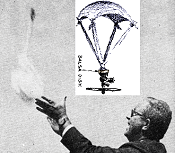 If you have a vintage Cox .010 Pee Wee engine
sitting on the display shelf and you've been itching to get it in the air again,
Ken Willard's Flying Bandanna (not Banana) could be just the thing to get you there.
This article appeared in a 1968 issue of American Aircraft Modeler magazine.
Ken claims it only takes about 10 minutes to assemble, and as he says of the bandanna
'parachute,' it is "...a built-in wiping rag for your hands after each flight!"
I remember as a kid when my .049-powered plastic Cox control line models had finally
be demolished beyond repair (no glue at the time would hold the styrene plastic
together for long), I would take what was left of the fuselage and launch it into
free flight with the engine screaming. Sad to say, but especially during the early... If you have a vintage Cox .010 Pee Wee engine
sitting on the display shelf and you've been itching to get it in the air again,
Ken Willard's Flying Bandanna (not Banana) could be just the thing to get you there.
This article appeared in a 1968 issue of American Aircraft Modeler magazine.
Ken claims it only takes about 10 minutes to assemble, and as he says of the bandanna
'parachute,' it is "...a built-in wiping rag for your hands after each flight!"
I remember as a kid when my .049-powered plastic Cox control line models had finally
be demolished beyond repair (no glue at the time would hold the styrene plastic
together for long), I would take what was left of the fuselage and launch it into
free flight with the engine screaming. Sad to say, but especially during the early...
 "Joe Barnard and Aryan Kapoor are two model
rocket enthusiasts who've spent years working to advance the hobby with innovative
ways to precisely
steer model rockets and land them vertically instead of just watching them parachute
back to Earth after a launch. Despite many failures and setbacks, they've each succeeded
in recreating SpaceX's Falcon 9 landing capabilities at a much, much smaller scale
and without billions of dollars of funding. Barnard, who studied music production
in college - not aerospace engineering - spent seven years designing, building,
and perfecting various custom components, including a custom thrust vectoring mechanism
for model rocket engines..." "Joe Barnard and Aryan Kapoor are two model
rocket enthusiasts who've spent years working to advance the hobby with innovative
ways to precisely
steer model rockets and land them vertically instead of just watching them parachute
back to Earth after a launch. Despite many failures and setbacks, they've each succeeded
in recreating SpaceX's Falcon 9 landing capabilities at a much, much smaller scale
and without billions of dollars of funding. Barnard, who studied music production
in college - not aerospace engineering - spent seven years designing, building,
and perfecting various custom components, including a custom thrust vectoring mechanism
for model rocket engines..."
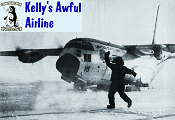 "The navigators who fly the regular routes
use everything they can. They use celestial navigation, but because there is-hour
daylight they can use only one star, the sun." That's a line from this "Kelly's
Awful Airline" article in a 1965 issue of Popular Mechanics magazine.
It describes one of the many challenges facing the crew of U.S. Navy Air Development
Squadron Six's Commander George R. Kelly as they perform many amazing feats of daring,
skill, and ingenuity. In such an unaccommodating environment as is the Antarctica,
bravery and determination are essential personal traits necessary for not just accomplishing
goals, but for basic survival. C-130s, C-47s, and what looks like a "Huey" (Bell
UH-1) flew day and night, in temperatures that can nearly... "The navigators who fly the regular routes
use everything they can. They use celestial navigation, but because there is-hour
daylight they can use only one star, the sun." That's a line from this "Kelly's
Awful Airline" article in a 1965 issue of Popular Mechanics magazine.
It describes one of the many challenges facing the crew of U.S. Navy Air Development
Squadron Six's Commander George R. Kelly as they perform many amazing feats of daring,
skill, and ingenuity. In such an unaccommodating environment as is the Antarctica,
bravery and determination are essential personal traits necessary for not just accomplishing
goals, but for basic survival. C-130s, C-47s, and what looks like a "Huey" (Bell
UH-1) flew day and night, in temperatures that can nearly...
 "Two
insect-like robots, a mini-bug and a water strider, developed at Washington State
University, are the smallest, lightest and fastest fully functional
micro-robots ever known to be created. Such miniature robots could
someday be used for work in areas such as artificial pollination, search and rescue,
environmental monitoring, micro-fabrication, or robotic-assisted surgery. Reporting
on their work in the proceedings of the IEEE Robotics and Automation Society's International
Conference on Intelligent Robots and Systems, the mini-bug weighs in at eight milligrams
while the water strider weighs 55 milligrams..." "Two
insect-like robots, a mini-bug and a water strider, developed at Washington State
University, are the smallest, lightest and fastest fully functional
micro-robots ever known to be created. Such miniature robots could
someday be used for work in areas such as artificial pollination, search and rescue,
environmental monitoring, micro-fabrication, or robotic-assisted surgery. Reporting
on their work in the proceedings of the IEEE Robotics and Automation Society's International
Conference on Intelligent Robots and Systems, the mini-bug weighs in at eight milligrams
while the water strider weighs 55 milligrams..."
 In the late 1970s, I was working on my private
pilot license and dreamed of building a homebuilt airplane. The Bowers Fly Baby
biplane was the first choice based on my nearly non-existent budget since it was
all-wood and used a 65 HP engine. What I really wanted was an
EAA Acro-Sport biplane.
I was a member of the Experimental Aircraft Association (EAA) at the time and first
learned of it in their monthly magazine. This scale rendition appearing in the November
1974 issue of American Aircraft Modeler magazine really made me want to
build one. Unlike the Pitts Special or the Christian Eagle, the Acro-Sport can be
tackled by most people of average building skills, and cost a whole lot less for
materials and powerplant... In the late 1970s, I was working on my private
pilot license and dreamed of building a homebuilt airplane. The Bowers Fly Baby
biplane was the first choice based on my nearly non-existent budget since it was
all-wood and used a 65 HP engine. What I really wanted was an
EAA Acro-Sport biplane.
I was a member of the Experimental Aircraft Association (EAA) at the time and first
learned of it in their monthly magazine. This scale rendition appearing in the November
1974 issue of American Aircraft Modeler magazine really made me want to
build one. Unlike the Pitts Special or the Christian Eagle, the Acro-Sport can be
tackled by most people of average building skills, and cost a whole lot less for
materials and powerplant...
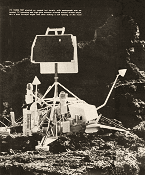 Surveyor 1, the first in a series of
seven, launched from Cape Canaveral on May 30, 1966 and landed on the moon at Oceanus
Procellarum on June 2, 1966. As the name implies, its mission was to analyze and
map the lunar surface in preparation for manned landings there at the end of the
decade. As detailed in this 1965 Popular Mechanics magazine article, Surveyor 1
was equipped with many instruments and tools for photographing, measuring, and testing
the moon's features and composition. Prior to its visit, nobody was certain whether
the lunar surface was covered with a thick layer of dust that would envelope a craft
and render a manned visit impossible. Turns out, the dust layer was quite thin.
Even so, there was still some concern prior to Apollo 11's landing, because
conditions might vary... Surveyor 1, the first in a series of
seven, launched from Cape Canaveral on May 30, 1966 and landed on the moon at Oceanus
Procellarum on June 2, 1966. As the name implies, its mission was to analyze and
map the lunar surface in preparation for manned landings there at the end of the
decade. As detailed in this 1965 Popular Mechanics magazine article, Surveyor 1
was equipped with many instruments and tools for photographing, measuring, and testing
the moon's features and composition. Prior to its visit, nobody was certain whether
the lunar surface was covered with a thick layer of dust that would envelope a craft
and render a manned visit impossible. Turns out, the dust layer was quite thin.
Even so, there was still some concern prior to Apollo 11's landing, because
conditions might vary...
|